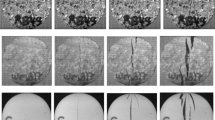Summary
An Experimental Determination of the True Uniaxial Stress-Strain Behavior of Brittle Rock
Results are presented of an experimental study of the behavior of six rock types deformed under uniaxial compression into their respective post-failure regions. Based on the observation that a rock sample in a post-failure state can be considered to be composed of broken and unbroken rock and assuming that the reduction in load-bearing capability of rock in the post-failure region is due to a reduction of the effective cross-sectional area of the specimen resulting from the growth of large cracks within the rock sample, we show that there is a maximum true stress that the unfractured solid rock can sustain without inelastic deformation. This stress is constant and is defined to be the true failure strength of the rock. The value of this stress is calculated by dividing the force on the rock sample at any point along the post-failure curve by the true load-bearing cross-sectional area of the rock sample at that point. Theoretical and experimental techniques are developed which allow an estimate of the true load-bearing area of the rock sample at any point along the post-failure curve of the sample. For the rock types used in the study, which were deformed to preselected positions along their respective post-failure curves and with the assumption that the fractured rock carried none of the applied load, the two techniques of measuring the effective load-bearing area give results which are equivalent.
Zusammenfassung
Experimentelle Bestimmung des wahren Spannungs-Dehnungs-Verhaltens von sprödem Gestein
Es wird über Ergebnisse experimenteller Studien über das Verhalten von sechs verschiedenen Gesteinen berichtet, welche unter einachsigem Druck im Nach-Bruch-Bereich deformiert wurden. Aufgrund der Beobachtung, daß eine Gesteinsprobe im Nach-Bruch-Bereich als aus brüchigem und gebrochenem Gestein zusammengesetzt betrachtet werden kann und unter der Annahme, daß die Abminderung der Belastbarkeit des Gesteins im Nach-Bruch-Bereich durch die Verringerung der wirksamen Querschnittsfläche der Probe infolge des Wachsens von großen Rissen in der Gesteinsprobe verursacht ist, wird gezeigt, daß es eine maximale wahre Spannung gibt, welche das ungebrochene, feste Gestein ohne inelastische Deformation ertragen kann. Diese Spannung ist konstant und wird als wahre Bruchfestigkeit des Gesteins angesprochen. Die Größe dieser Spannung errechnet sich durch Division der auf die Gesteinsprobe an irgendeinem Punkt der Nach-Bruch-Kurve ausgeübten Kraft durch die wahre, Belastung tragende Querschnittsfläche der Gesteinsprobe an diesem Punkt. Es wurden theoretische und experimentelle Techniken entworfen, welche eine Schätzung der Verminderung der Belastungsfläche an irgendeiner Stelle längs der Nach-Bruch-Kurve der Probe erlauben. Für Gesteinstypen, welche in diesen Untersuchungen benützt wurden und welche an im Voraus gewählten Stellen längs der Nach-Bruch-Kurve deformiert wurden, gaben unter der Annahme, daß das gebrochene Gestein nichts von der aufgebrachten Belastung trug, die beiden Techniken zur Messung der tatsächlich lasttragenden, wirksamen Fläche gleiche Resultate.
Résumé
On présente les résultats d'une étude expérimentale du comportement de six types de roches chargées en compression simple dans leur domaine respectif de déformation après la rupture. Si l'on remarque qu'un échantillon de roche après la rupture peut être considéré comme composé de roche cassée et de roche non cassée, et en supposant que la réduction de résistance dans le domaine après la rupture est due à la réduction de la section droite intacte de l'échantillon, réduction résultant de la croissance de grandes fissures dans l'éprouvette, on montre qu'il existe une contrainte vraie maximale que la roche peut supporter sans déformation permanente. Cette contrainte est constante et est réputée être la résistance vraie à la rupture. La valeur de cette contrainte est calculée en divisant la force sur l'échantillon en chaque point de la courbe effort-déformation après la rupture, par la section droite supportant alors véritablement la charge. Des techniques théorique et expérimentale sont développées, qui permettent d'estimer la surface portante vraie de l'échantillon en tout point de la courbe après la rupture. Pour les types de roches utilisées dans cette étude, qui furent déformées à des états pré-déterminés du domaine après la rupture, et avec l'hypothèse que la roche fracturée ne supportait plus aucune contrainte, les deux méthodes de mesures de la section portante ont donné des résultats équivalents.
Similar content being viewed by others
References
Bieniawski, Z. T., H. G. Denkhaus, and U W. Vogler: “Failure of Fractured Rock”, Internat. J. Roch Mech. Min. Sci., vol. 6, pp. 323–346, 1970.
Bieniawski, Z. T.: “Time-Dependent Behavior of Fractured Rock”, Rock Mechanics, vol. 2, no. 3, pp. 123–137, Sept. 1970.
Blake, Wilson: “Destressing Test at the Galena Mine, Wallace, Idaho”, Presented at Annual AIME Meeting, New York City, New York, 1971.
Brady, B. T., W. I. Duvall, and F. G. Horino: “A Study of the Post-Failure Characteristics of Brittle Rock”, Rock Fracture Symposium Proceedings, Nancy, France, 1971.
Cook, N. G. W.: “Failure of Rock”, Internat. J. Rock Mech. Min. Sci., vol. 2, pp. 289–403, 1965.
Horino, F. G., B. T. Brady, W. I. Duvall, and V. E. Hooker: “A Thousand-Ton Capacity Stiff Testing Machine”, BuMines Report of Investigations 7624, 1972, 19 pp.
Rummel, F., and C. Fairhurst: “Determination of the Post-Failure Behavior of Brittle Rock Using a Servo-Controlled Testing Machine”, Rock Mechanics, vol. 2, no. 4, pp. 189–204, Dec. 1970.
Scholz, C. H.: “Microfracturing and the Inelastic Deformation of Rock in Compression”, J. Geophys. Res., vol. 73, pp. 1417–1432, 1968.
Wawersik, W.: “Detailed Studies of Rock Fracture in Compression”, PhD Thesis, University of Minnesota, 165 pp., 1968.
Author information
Authors and Affiliations
Rights and permissions
About this article
Cite this article
Brady, B.T., Duvall, W.I. & Horino, F.G. An experimental determination of the true uniaxial stress-strain behavior of brittle rock. Rock Mechanics 5, 107–120 (1973). https://doi.org/10.1007/BF01240161
Received:
Issue Date:
DOI: https://doi.org/10.1007/BF01240161




